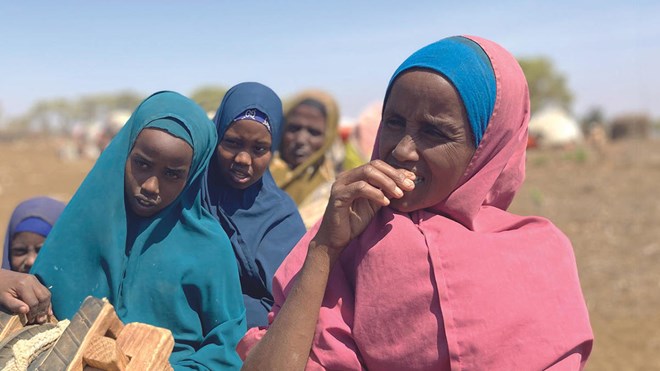
Saturday November 18, 2023
The reality of displacement in Somalia

The heat is scorching. The dust hangs heavy in the air in this small settlement in Baidoa, Somalia. A donkey cart slowly passes by, bringing yet another family who have been forced to flee their home due to the drought.
On a recent field visit, NRC communications adviser Claes Holmberg saw first-hand how the climate crisis is affecting families in rural Somalia.
The drought had ravaged their land. The crops had withered away, and the few livestock that had survived had to be eaten to stave off hunger.
Finally, the family made the difficult decision to leave. They secured a few essential belongings to their cart and set out for Baidoa. They reached out to families who had fled the village before them and got the directions to this exact camp.
They hope to find safety and shelter here.
“As you can see, we only have this donkey. We had to eat our last living livestock on the road.” Mumino Ibrahim Hassan, a mother of eight children.
Mumino’s family is not alone in their struggle. Every day, between 10 to 15 families arrive at this settlement. The influx has been going on for well over a month now. In the city of Baidoa, there are more than 300 similar camps. In another settlement outside the capital Mogadishu, I witnessed the arrival of over 300 new families in a single day.
The situation is dire, and the challenges are immense.
Climate change in Somalia
Somalia is highly vulnerable to the effects of climate change. Recurrent droughts are devastating communities and exacerbating longstanding conflicts and tensions. Millions of people have been forced to flee their homes in recent years, and half the population is in need of lifesaving assistance.
According to the Internal Displacement Monitoring Centre (IDMC), there were over 4 million people displaced within in Somalia at the end of 2022. That number continues to rise.
Good neighbours in a harsh environment
It is midday and the temperature has reached 38C. The scorching heat and constant barrage of wind-blown sand give me a brutal taste of the harsh environmental conditions faced by the people living in this arid region.
It is now urgent to build a shelter for Mumino’s family. Newly arrived families have already started constructing temporary homes using whatever materials they can find – mostly bushes and sticks. It is common for a family here to have up to ten members, and it’s not hard to imagine the challenging conditions that might exist in shelters for such large households.
Following my conversation with Mumino, it becomes clear that this family shares deep connections with their new neighbours. They have a bond forged in the tragedy of displacement, a sense of unity and belonging in an unfamiliar place.
A neighbour, in this context, might be a fellow villager or even a distant relative. Through their shared hardship, they become more than just neighbours – they become a support system.
As I observe Mumino’s children, their wide eyes exploring this new environment, I wonder if they might catch sight of a familiar face, an old friend from the village they were forced to leave behind just two weeks ago? Perhaps it would provide some comfort in the desperate circumstances they find themselves in?
Children are particularly vulnerable to the impacts of displacement. In situations like these, the priority list of needs starts with essentials such as water and food, while education falls to the bottom.
Limited resources
One of the key challenges of climate displacement in Somalia is the lack of resources and infrastructure to support displaced communities. Many families find themselves living in makeshift shelters with limited access to clean water, food and healthcare.
However, an increasing number of landowners are stepping forward to provide displaced people with a vital resource: fresh water. This commendable initiative is evident in the settlement where I meet Mumino.
As Mumino and her family talk, their fear and uncertainty are clear to see. They have no idea what the future holds, but they know they had to leave their home to survive. This is a new start for them.
“We left because of the climate, not the conflict,” says Mumino, emphasising that fleeing was their only viable option. Staying put was simply unsustainable. Droughts inevitably result in food shortages, which, over time, can escalate into devastating famines.
Embracing their destiny
What astonishes me is the way that the family have already embraced their destiny. They’ve fled a considerable distance, from one location to another, and now this place is their newfound sanctuary. It is a testament to their determination and resilience rather than a sign of hopelessness.
I’ve visited displacement sites in other countries before, meeting individuals in similar difficult situations, yet this response strikes me as unique. In most cases, people who have fled within their own country long to return home, but not in Somalia. Conflicts may end, but climate change is harder to reverse. “Home” for Mumino is not a viable option in the foreseeable future.
We leave the settlement and it is a stark contrast that highlights the privileges afforded to me as humanitarian staff working for an international humanitarian organisation. I can leave, while they must remain.
As we drive away, my colleagues inform me of a brief stop up ahead. We pull over, and my gaze is drawn to the right, where I witness a family labouring to construct a house, one made of sturdy bricks.
This is no ordinary house. It symbolises the opportunities that the community is providing for displaced people like Mumino, a chance to build a foundation for a new life in the future. This house stands as a testament to NRC’s durable solutions efforts, tailored for the displaced community in Baidoa and supported by UN-HABITAT. It reminds me that lasting solutions are possible for those who have experienced the harshest of challenges. There is hope for the displaced of Somalia.